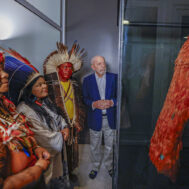“It’s so important to understand how Rio Tinto came like a thief in the night and blew away a site … that surpassed the last ice age.” Protest organizer at a demonstration Robert Eggington, a Noongar man.

Canyon at Weano Gorge, Karijini National Park, Author Bob Tarr, 25 July 2014, CC BY-SA 4.0 International license via Wikimedia Commons.
In Australia, States and Territories – not the federal government – have the primary responsibility for protecting cultural heritage. One result has been that there are significant differences in cultural heritage laws across Australia. In some states, archaeological importance may have greater weight than indigenous cultural significance. In general, laws protect a broader public interest instead of focusing on Aboriginal communities. And in some regions, especially in Western Australia, the power and influence of extractive industries has left a 50-year legacy of laws and industry practice that allows destruction of highly important Aboriginal heritage sites without the legal right to appeal.
Major changes have taken place at multi-national mining company Rio Tinto in the wake of revelations that it blew up ancient sacred sites in Western Australia’s Juukan Gorge on May 24, 2020. The two rock shelters, dating to 46,000 years ago, were of great importance to the Puutu Kunti Kurrama Pinikura people (PKKP), their Aboriginal traditional owners. The PKKP learned of the planned destruction of the cave sites on May 15, just days before their destruction, when they came to prepare for a ceremony and found drill holes made ready for explosives.
Rio Tinto operates sixteen iron ore mines in Pilbara, a dry region in the north of the state of Western Australia. Pilbara is the location of the Juukan Gorge and many other beautiful natural landscapes; it is also the source of 30% of all resources in Australia, particularly of its oil, gas, and mining industry. The region contains almost 316,000 square miles but its population is only 66,000.

Colors of Karijini National Park, Author Baras, 2006, CC BY-SA 3.0 Unported license.
Rio Tinto chose to destroy the two ancient and archaeologically unique rock shelters in the Juukan Gorge in order to gain easier access to iron ore deposits worth $135 million. The company failed to inform Aboriginal owners that there were three alternative mining options that would have left the ancient caves intact.
The destruction of some of Australia’s earliest archaeological sites by Rio Tinto caused outrage in Australia and around the world. The mining company executives’ defense that they had not understood the site’s importance has been questioned both by investors and parliamentary investigators.
Senior executives at the company stated that they had not read a 2018 archaeological report that described the Juukan Gorge site as having the “highest archaeological significance in Australia.” However, it now appears that Rio Tinto received five separate reports on the significance of the caves since 2013. The chairman of the parliamentary inquiry set up after the destruction of the cave sites stated that it “beggared belief” that the company was not aware that there were serious concerns with the plan to blast the cave sites.
In June 2020, information was released showing that five days prior to the blasting of the Juukan Gorge sites, representatives of the Puutu Kunti Kurrama Pinikura group had met with state government officials at the Western Australia Aboriginal Affairs Department to raise concerns about the sites and that the department then contacted Rio Tinto to inform the mining company of the meeting.
The department did not contact its Minister, Ben Wyatt, who has said that he did not know about the destruction until too late. Wyatt said that he had met with PKKP advisers on May 19 but not with the actual traditional owners. He said the advisers had “sought confirmation of their understanding of the section 18 consent order issued for the Brockman mine in 2013, and sought confirmation that such consents cannot be revoked.” Aboriginal Affairs Department officers then confirmed that under Western Australia law the consents could not be revoked. (ALT: He said the advisers had “sought confirmation of their understanding of the section 18 consent order issued for the Brockman mine in 2013, and sought confirmation that such consents cannot be revoked,” which Aboriginal Affairs Department officers then confirmed.) However, subsequent investigation has shown that while Rio Tinto may have followed the letter of the law, it disregarded warnings and failed to obtain informed consent from Aboriginal title holders.
Shareholders outraged by Rio Tinto actions
Rio Tinto’s destruction of an irreplaceable, 46,000 year old site and its failure to work with Aboriginal representatives triggered both public protests and sharp criticism from shareholders around the world. Major investors including Australia’s largest pension funds have publicly condemned both the destruction and Rio Tinto company officials’ failure to heed warnings from Aboriginal partners. Calls for executives’ resignations came from numerous major shareholders.
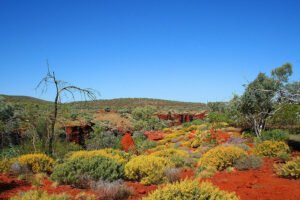
Colors of Karijini National Park, Author Baras, 2006, CC BY-SA 3.0 Unported license.
Andrew Gray, a director at the pension fund, AustralianSuper, which holds $1.3 billion in Rio Tinto shares, called for “true accountability.” The chief executive of AustralianSuper stated that a report on the destruction revealed “profound systemic, operational and governance failings.”
On September 9, one of Australia’s largest retirement (superannuation) funds, Hesta, which manages $52bn in investments for 870,000 Australians, said that “Mining companies that fail to negotiate fairly and in good faith with traditional owners expose the company to reputational and legal risk.” The Hesta statement added that, “The larger, systemic issue of how the company and the mining sector negotiates agreements with Traditional Owners needs to be urgently addressed.”
The site’s destruction was immediately condemned by shareholder advocacy group the Australian Centre for Corporate Responsibility, which demanded the resignation of Rio Tinto’s chief executive, Jean-Sébastien Jacques. Brynn O’Brien, the executive officer of the Australasian Centre for Corporate Responsibility, said that, “The destruction of Indigenous heritage is a part of the mining industry in WA, but it’s something that community views have finally caught up with and I think investor views have caught up with it as well.” The group described the site destruction as a “breathtaking breach of a respectful relationship.”
Rio Tinto’s initial response – that executives would lose their bonuses – was deemed wholly inadequate and “little more than a public relations exercise” by the Australian Centre for Corporate Responsibility: “Tens of thousands of years of cultural significance get blown up and all that goes to show for it is $7m of lost remuneration.” Many others agreed. By September 11, 2020, the investor criticism resulted in resignations of three top Rio Tinto executives, including CEO Jean-Sébastien Jacques, iron ore head, Chris Salisbury, and Simone Niven, the head of corporate affairs.
Native title holders disadvantaged
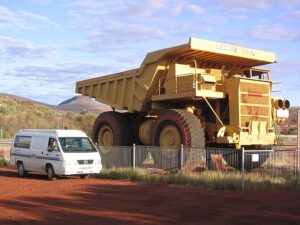
Lectra Haul, Karijini National Park, Author Phil Whitehouse, London, United Kingdom, 26 May 2004, CCA 2.0 Generic license via Wikimedia Commons
Jamie Lowe, chief executive of the National Native Title Council said that structural change at Rio Tinto was inadequate to ensure the preservation of historic sites, and called for laws on heritage to be strengthened, saying that, “We can’t rely on their word that things will get better.”
Mining companies already have obtained permission to damage over 450 sites in the last ten years. Aboriginal owners say that they have long been pressured to negotiate their rights away, and that “appealing to the mine owners’ better nature” will not preserve sites. They note that Western Australia’s state government’s laissez-faire attitude to development was also a factor in site destruction. Western Australia’s 48-year-old heritage laws establish permitting regimes that allow destruction of Aboriginal sites many years after contracts are agreed to. The traditional owners want existing exemptions under Western Australia’s Aboriginal Heritage Act 1972 that allows sites set to be damaged or destroyed to be reviewed.
Under the Aboriginal Heritage Act, the state’s legal environment prioritizes development at the cost of destruction of cultural heritage. In 2013, the state government had granted approval of plans to destroy the Juukan Gorge caves in order for Rio Tinto to expand its Brockman 4 mine. A recent article in The Guardian described over 100 additional sites currently at risk including:
Tharbadu or Djadjiling (Mount Robinson): between 40 and 86 significant sites of the Banjima people, including sites up to 15,000 years old that are at risk from damage in a BHP Billiiton project (see more on this project below),
Weelamurra: Fortescue Metals Group has sought approval to destroy several sites including dozens of rock shelters, two of which contain evidence of human occupation extending back even further than Juukan Gorge. One was dated at 60,000 years old, the other 47,800…
Yirra: an important Yinhawangka site in the Hamersley range showing evidence of occupation from at least 23,000 years ago, which was used to prove the theory that the range was a place of climate refuge at the end of the last ice age, and a central point for colonizing the rest of the Pilbara.

Dales Gorge, Karijini National Park, Author Martin Kraft (photo.martinkraft.com) License: CC BY-SA 3.0 via Wikimedia Commons.
While mining development has potential to bring significant funds and employment to Aboriginal groups, it also can result in the fractionalization of indigenous groups, only some of whom benefit financially.
Historically, native title holders in Australia have been squeezed between the need for funds and jobs and losing rights over lands that contain heritage sites to oil, gas, and mineral extractors. For all, the compensation rarely mitigates the cultural loss.
Rio Tinto has two main competitors who mine iron ore in the Pilbara region of northern Western Australia, Fortescue Metals Group (FMG) and BHP Billiton (BHP). All have said that they will not proceed with destruction of sites without consultation with traditional title owners, but there is insufficient legal compulsion for consultation – and only public involvement keeps companies from going forward regardless of the indigenous people’s concerns.
Fortescue chief executive Elizabeth Gaines said in June that it had “worked with our Native Title partners to protect over 5,000 significant Aboriginal cultural heritage places across our operations.” Fortescue has seven native title land access agreements, and recently lost a highly contested and bitter federal high court case in which the company may have to pay millions in compensation to traditional title owners, the Yindjibarndi people. The court granted the Yindjibarndi exclusive title to a large section of land in the Pilbara which includes the site of the important Solomon Hub iron ore mine. Fortescue takes in 44.29 billion in revenue annually
BHP Billiton backs off another planned destruction of heritage sites

Varanus hammersleyensis from Kirijini National Park, Western Australia, Author Evan Pickett, 30 May 2017, CC BY-SA 4.0 International license.
Another Aboriginal group, the Banjima people, faced even more planned destruction. Just a few days after Rio Tinto detonated traditional sites in the Juukan Gorge, the major mining company BHP Billiton received state government approval of its plans to destroy up to 86 rock shelters and sites dating from 8,000-13,000 BCE through its mining activities in Western Australia. The BHP Group is the largest mining company in the world measured by stock capitalization.
Despite issuance of the permit for destruction, press attention as a result of the Juukan Gorge destruction prompted a reversal of BHP’s plans. An article appeared in The Guardian about the Banjima sites stating that they included “culturally modified trees, rock shelters with painted rock art, stone arrangements” and 40 “built structures … believed to be potential archaeological sites.” Within hours of the appearance of the Guardian article, BHP Billiton promised that it at least would not demolish the 40 sites that it held to meet a specific standard of cultural importance.
Traditional owners say that while they signed an agreement to allow the South Flank mining project in the area of these sites, preserving them is essential for their spiritual and physical well-being; until now, their pleas to use alternative methods had been ignored by the company.
Mining companies have the legal advantage; Aboriginal groups cannot appeal
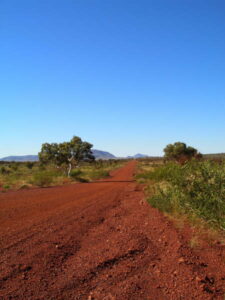
Karijini National Park, Author Aenneken, 22 July 2006, Creative Commons Attribution 2.0 Generic license via Wikimedia Commons.
The heritage legislation governing Aboriginal sites and materials in the state of Western Australia is the Aboriginal Heritage Act 1972 (AHA). Under the AHA, heritage sites are protected but the state government can grant permission to “impact,” i.e. destroy the sites if their traditional owners have signed contracts for mining extraction on their lands. Section 18 of the Aboriginal Heritage Act (ACA) both grants permission to exploit the land and threatens legal action against any landowner that later objects to the state government’s granting of an exception to the protected status of sites.
Once traditional landholders like the Banjima people appoint an agent to consent to usage of land including heritage sites, they are no longer allowed to object or to publicly lodge objections to the site destruction. The single page Section 18 land owner consent letter states that:
I/we understand that where consent has been given by the Minister for the use of any land for a particular purpose, any person acting on my/our behalf that does any act(s) outside of that consent may constitute an offence against s17 of the AHA or against any conditions that form part of the consent.
In other words, once consent is given for general use of the land, and the government issues an exception under Section 18, the landowners cannot object without breaking the law.
This legislation then supports contractual agreements between mining companies and traditional title holders that prevent the title owners from speaking out in the future against proposed destruction.
Investment and retirement funds have also raised this point. Hesta stated:
“These risks increase the longer these agreements are in place. Without an independent review, we cannot adequately assess these risks and understand how they may impact value. We have lost confidence that the company can do this on their own.”

Karijini National Park, Author Phil Whitehouse, London, United Kingdom, 25 May 2004,
CCA 2.0 Generic license via Wikimedia Commons.
Hesta consulted with academic and legal experts as well. One such expert, Professor Allan Fels told The Guardian that with regard to confidentiality clauses in contracts with Aboriginal owners, “There are potential unconscionable conduct issues, both at the legal and ethical level. They need to be investigated independently.”
On June 11, Australia’s Senate agreed that its Joint Standing Committee on Northern Australia should hold an inquiry into the blasting of the caves at the Juukan Gorge. The inquiry will also consider how the federal government might use its powers to prevent the recurrence of such actions and to change the implementation of Western Australian heritage laws. Changes to these laws are now being considered – but again – the problem also lies with past agreements. Many Australians are calling for a moratorium on the issuance of new Section 18 exemptions that allow destruction of heritage – but in many cases these exemptions were granted long ago and may still be used to damage or destroy other sites. On August 31, the Senate agreed to a reporting extension for the inquiry being done by the Joint Standing Committee on Northern Australia and the report deadline was extended to 9 December 2020.
How archeological professionals regard the state of the law
Emma Beckett and J.J. McDermott conducted and published an online survey on the current state of cultural heritage management in Australia, collecting information first at the Australian Archaeological Association’s annual conference in 2015 and then opening the survey to the public.[i] The majority of respondents were academics and consultants although government represented a 16% share; traditional owners and aboriginal consultants were only 1% of respondents.
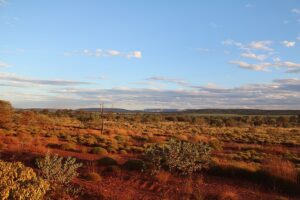
Karijini National Park, Author Warren Poole, 6 October 2016, CC BY-SA 4.0 International license.
Unsurprisingly, the majority of respondents believed that federal heritage protection overall should be increased and that this was most needed for Aboriginal heritage. Questioned whether Aboriginal and historic heritage legislation should be combined, respondents were split; many cited issues of discrimination and reconciliation with Aboriginal peoples and noted that the protection of Aboriginal heritage suffers as a result of its separation from historic and other types of heritage legislation. Acknowledging that protection and preservation were unevenly balanced and resulted in racial discrimination, many nonetheless felt that applying the same laws to both would not be workable or in the end, mitigate unfairness.
A high proportion felt that Aboriginal people have very little power in protecting their own heritage and many noted that was the case especially in Western Australia, given the lack of recourse of Aboriginal people to appeal decisions made about their own cultural heritage. Developers and mining companies, as well as some heritage professionals “exerted considerable influence on Aboriginal people.” The respondents identified indigenous land use agreements (ILUAs) as creating fractures within Aboriginal groups. Other key problems identified in the survey were that:
- The threshold at which legislation protects cultural material is too high;
- There is no incentive for developers to support high quality heritage work;
- It is easier to apply for the permits to destroy cultural sites than to undertake mitigation or conservation;
- Government in general and in Western Australia in particular purposefully avoid clarifying expectations;
- Western Australia legislation and regulations lack clear criteria and basic standards so local councils and developers don’t understand the basic processes of heritage documentation and preservation;
- Recently proposed changes to the Aboriginal Heritage Act may make this problem even worse; and
- There is poor circulation of information and guidance and overall lack of consultation with heritage professionals and Aboriginal people.
[i] Emma Beckett & J.J. McDermott, An online survey regarding cultural heritage management and the law in Australia, Journal of the Australian Association of Consulting Archeologists, Vol 4 (Supp) 2016.
 Rothschild's rock-wallaby (Petrogale rothschildi) from Karijini National Park, Author Evan Pickett, 30 May 2017, CC BY-SA 4.0 International license.
Rothschild's rock-wallaby (Petrogale rothschildi) from Karijini National Park, Author Evan Pickett, 30 May 2017, CC BY-SA 4.0 International license. 
